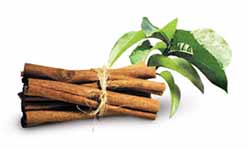IN conjunction with World Diabetes Day, which falls on November 14 each year, (to mark the birthday of Frederick Banting, who along with Charles Best, first conceived the idea which led to the discovery of insulin in 1922), this article will focus on two herbal plants, cinnamon and banaba, which have been found to help control high blood sugar levels.
Insulin resistance – pre-diabetes and diabetes
Pre-diabetes and type 2 diabetes usually begin with insulin resistance. Researchers now know that diabetes does not just appear out of nowhere. Before diagnosed as having diabetes, you have a condition known as pre-diabetes. This condition is where your blood sugar is higher than normal but not high enough to be called diabetes.
That is not good news because people with pre-diabetes not only have a high risk of diabetes, but that pre-diabetes is also a risk for of heart attacks, strokes, kidney failure, blindness and nerve damage.
The best way to combat diabetes is at the pre-diabetic stage. A healthy diet, exercise and taking supplement can prevent or delay the onset of diabetes and reduce the risk of complications.
Blood sugar (glucose) levels in the body is regulated by insulin, a hormone produced in the pancreas. Insulin helps to transport glucose from the blood through the cell membranes and into the cells of the body.
As long as the cell membranes remain sensitive to insulin, the shuttling of glucose into the cells occurs quickly. When the cell membranes become insensitive to insulin (also called insulin resistance), the pancreas will have to pump out more insulin in an attempt to force the glucose into the cells. When this effort is not so effective, the result is high levels of sugar circulating in the blood (considered a pre-diabetes condition).
Eventually, over time, the pancreas can no longer produce enough insulin to control blood sugar, and type 2 diabetes develops.
Water-soluble standardised cinnamon extract

Dr Richard Anderson, a chemist at the US Department of Agriculture (USDA), was searching for foods that might mimic the action of insulin in controlling blood sugar (glucose) levels. He found a class of water-soluble compounds in cinnamon called polyphenol type-A polymers to have the ability to boost insulin’s activity about 20-fold. This insulin boosting property of cinnamon could benefit people with high sugar levels (pre-diabetics and diabetics).
In June 2006, a study showed that daily supplementation with water-soluble extract of cinnamon helped to improve sugar levels in people with type 2 diabetes. In the study, 79 diabetics took the supplement three times daily. After four months, their fasting blood sugar levels improved by 10.3%.
Furthermore, diabetics who had higher initial blood sugar levels benefited more from taking the supplement.
Water-soluble cinnamon extract also has antioxidant properties. In October 2006, a study presented at the 47th American College of Nutrition demonstrated that water-soluble cinnamon extract may provide protective antioxidant effects in reducing free radical damage associated with high blood sugar levels.
Additionally, the study showed improved blood sugar control. The results of this study further support the role of cinnamon extract in helping people suffering from impaired insulin function and pre-diabetes.
Water-soluble cinnamon polyphenol type A polymers extract is 70% more effective than whole cinnamon itself and avoids the potentially harmful allergic side-effects that can occur when using high doses of whole cinnamon.
Banaba standardised extract
A number of medicinal plants from India, China and Japan are used for diabetes. One of the most effective plant compounds discovered is corosolic acid found in the leaves of the banaba (lagestroemic speciosu) tree.
Dr Yamazaki, professor of pharmaceutical science, Hiroshima University School of Medicine, Japan, studied the effects of corosolic acid in relation to its insulin-like properties. His studies indicate that corosolic acid activates the transport of glucose across the cell membranes into the cells, resulting in blood sugar reductions.
Corosolic acid acts like insulin, the hormone that naturally increases glucose transport activity across cell membranes, thus facilitating the lowering of blood sugar. Clinical studies in the US and Japan show that corosolic acid is safe and effective in lowering blood sugar levels in pre-diabetes and type 2 diabetes.
Individually, cinnamon and banaba extracts increase insulin sensitivity, which helps to lower blood sugar levels. When the two are combined, they are more effective.
Most of the research on cinnamon are using the water-soluble extract standardised to contain trimeric and tetrameric A-type polymer (polyphenol type A polymer), and as for banaba, it is standardised to contain 1% corosolic acid.
If you are at risk for pre-diabetes, ask your doctor to give a blood test. Even if you consider yourself not at risk, experts now advice those over 35 years of age to check their blood sugar levels annually.
However, if you know you have pre-diabetes, you could still prevent the onset of diabetes and reduce damage to your body through changes in diet and exercise, and also consider supplements such as water soluble standardised extracts of cinnamon and banaba.
Having said that about the benefits of both cinnamon and banaba, it is also crucially important to ensure you take a good multivitamin and mineral supplement that has been specially formulated for diabetics and pre-diabetics in mind to help optimise health and prevent illnesses.
Specific key nutrients that diabetics need in a higher amount than those found in the ordinary daily multivitamin and mineral formula are vitamin B1, B6, B12, biotin, niacinamide, vitamin C, vitamin E, manganese, vanadium, zinc, chromium and selenium.
Diabetics also need more of alpha lipoic acid, a universal antioxidant which can function in both the watery and fatty regions of the cells.
These supplements are to be taken with current medication and are not intended to replace the medication and advice of a physician.
